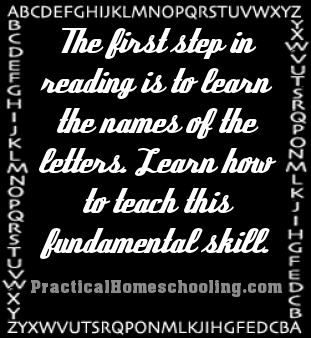Teaching the Alphabet
By Sam Blumenfeld
Printed in Practical Homeschooling #43, 2001.
 The first step in reading is to learn the names of the letters. Learn how to teach this foundational skill.
The first step in reading is to learn the names of the letters. Learn how to teach this foundational skill.

|
 |
 Few moments in childrearing are more enjoyable than those spent teaching a child the alphabet. I've seen the joyful look that lights up a child's face as she repeats the alphabet letters, coached by a parent or tutor. The child realizes that she is beginning to learn to make sense of printed matter.
Few moments in childrearing are more enjoyable than those spent teaching a child the alphabet. I've seen the joyful look that lights up a child's face as she repeats the alphabet letters, coached by a parent or tutor. The child realizes that she is beginning to learn to make sense of printed matter.
The first step in this process is learning the letter names. Some pedagogues believe that teaching the letter sounds should precede teaching the letter names. They contend that teaching the letter names first may confuse the child when learning the letter sounds.
I disagree. The child should be taught the letter names because all objects have names, and we identify them by their names. The child has seen letters all over the place in this literate world. She has seen them in the storybooks her parents read to her. The child hasn't a clue what the letters mean until she is taught their sounds. That's when you explain what the letters mean. Learning the letter names is just the beginning of the long process of understanding.
There are many ways to teach the alphabet. The easiest way is to use the "Alphabet Song." Arrange the alphabet in the form of a rhyming poem to be recited as in the box at right. Note that w is on a line by itself, because it has three syllables: "dou-ble-you."
Children learn to sing the Alphabet Song correctly before they can identify the letters at random. Thus, after the child knows the alphabet song, get a set of alphabet flash cards or make a set of your own. Teach both lower-case and upper-case letters. Show the child the letters at random and see if she can name them. Don't worry if she has problems remembering the letters. She will learn them much better when you start teaching the letter sounds during which she will be learning to read words and simple sentences.
If you want to be creative and make your own flash cards, print out letters from your computer, or cut out letters from newspaper headlines and magazine ads.
You can ask your child to look at a magazine ad and have her cut out the letter c or m or any other letter. Your child may even help you make a set of flash cards.
Sometimes, just knowing the letter names helps a child learn to read on his or her own. There are indeed precocious children who actually teach themselves to read. Of course, there is no law that says you can't teach the letter sounds anytime you want. A good phonics program would be useful to have on hand in case your child wants to move ahead speedily. I recommend a program without pictures, so that the child understands that letters stand for sounds and will concentrate on what the letters say rather than what a picture says. Pictures delay learning and encourage guessing.
If a child has learned to read with lots of pictures, he or she will be discouraged when faced with a page of nothing but print. A fluent phonetic reader who has learned to read without pictures will not be fazed by a full page of print.
As you teach the alphabet your child may want to draw the letters. Get a large drawing pad and markers and let your child copy the letters as they appear in books or magazines. In other words, don't use ball-and-stick manuscript.
Once you begin teaching the letter sounds, then start teaching your child to write in cursive. The reason for this is simple: if a child learns cursive first he or she will always be able to learn to print very nicely later on. But if you teach manuscript - or print script - first, your child may never develop a good cursive handwriting. When children spend a year or two writing in manuscript, they develop writing habits that create obstacles to the development of a good cursive script - or, as it was once called, penmanship.
In sum, teaching your child the alphabet should be the most pleasant task you can perform. It is a milestone in your child's growth, and a wonderful time to remember. You may even want to tape your child reciting the alphabet as he or she is learning it so that the both of you can listen to it twenty years hence, and laugh - or cry.